|
|
 |
|
It was time for some more learning and
there were two most desired educations for me: either
the study of Biology or Veterinary Science. Well, I
became a vet and worked in equine practice later on, but
first, before going to vet school in Utrecht, where the
only Dutch veterinary education is provided, I had to
decide about Oriante and the colt I had bred with her.
|
|
The youngster was sold but for the mare I
managed to find a place in the outskirts of
Utrecht, near to the university. With her, I
even participated in the veterinary
students’ club riding lessons. However, one
year later, my horse was struck by lightning
and I was harshly put on my feet as a
horseless person again.
Oriante
had been bred to a beautiful Fjord stud, an
original import from Norway. After her
death, the stallion keeper invited me to
ride his horses and help him at shows, so I
rode his Norwegian stud, a Dutch Appaloosa
(a registry breeding for the pattern, with
horses in various sizes) and a Haflo-Arab, partbred Haflinger. |
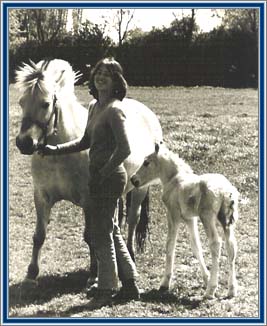
Oriante with her colt at
one day old |
|
|
Being without a horse gave me more
opportunity to travel, with England being my preferred
destination. I had been in London and Leicester already,
together with my father. In Leicester we went to a sale
organized by the British Driving Society and bought a
patent leather harness which I had measured to fit
Oriante. Amazingly as we found out later, this harness
also fit the much bigger Friesian mare, Antje, very
well. In London I soon found “The Horseman’s Bookshop”
of J.A. Allen & Co. This was the place where (on another
visit) I found the book “Saddle Seat Equitation” by
Helen K. Crabtree, - a real eye opener, this book! |
|
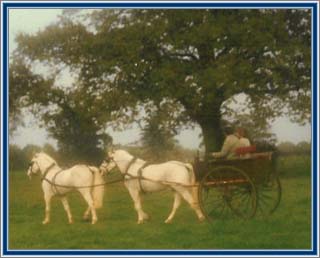
Tandem driving with Mr.
Vine
|
At a later visit to England, together
with a girlfriend, I got tandem driving
lessons from Mr. Vine in Sussex. Again, the
British Driving Society provided me with the
address and it was a delight to stay with
the Vine family and drive their
Arab-Percheron crosses on the left side of
the road! |
|
|
During my veterinary study I got involved
in the IVSA, the International Veterinary Students’
Association. We organized a students’ congress in
Utrecht and my work in the IVSA’s ExCo brought me to
several countries. As such, I visited England, Ireland
and South Africa.
For the students’ congress in Liverpool
we got an official reception in the town hall, and were
introduced to the Mayor and to the Duke of Edinburgh,
Prince Philip, who delivered the opening speech of our
congress. At the time, I didn’t promote Tennessee
Walkers yet, otherwise that could well have been the
subject of conversation with Prince Philip! Instead, we
discussed his Fell ponies, a rare breed which he helps
to survive.
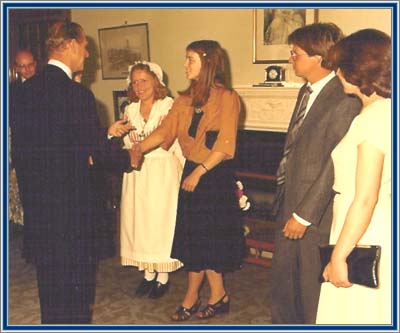
Shaking hands with the Duke of Edinburgh, in Liverpool
Town Hall
In South Africa I stayed in the
veterinary students’ hostel of Pretoria University. This
extended visit was a major experience, where I visited
Game Farms, populated with native antelopes, and of
course, horse breeders. I found horses of the South
African breeds, Basuto Pony, Nooitgedacht Pony and
Boerperd, as well as American Saddlebreds in the RSA.
|
|
In Europe, I also went east and south in
my quest for fine horses. The first visit on
my own to Germany brought me to owners of
Friesians and Peruvian Paso’s. Sure, here I
was already infected with the “gaited horse
virus”, a very resilient one! The popular
Icelandic Horses introduced me to the world
of gaited horses and I stayed hooked.
|

On Peruvian Paso gelding Don Juan, in
Germany
|
|
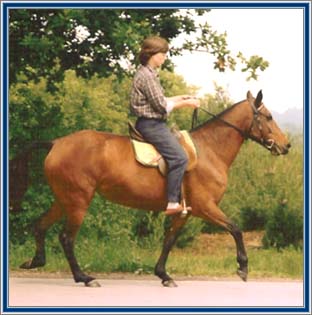
On pregnant Mangalarga Marchador
mare, Gaucha |
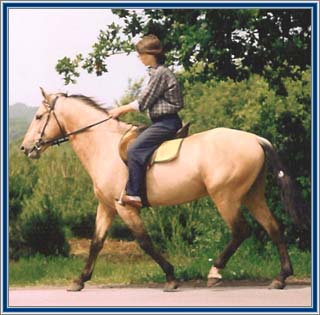
Introduction to the Mangalarga Marchador
breed,
on stallion Nero |
|
|
In Germany four beat gaits
were making a come-back, well promoted by that grand old
lady of gaited horses, Ursula Bruns. She introduced me
to the gaited German Trotters which she trained and to
the first imported Mangalarga Marchadores from Brazil.
Ursula Bruns also had an old Basuto gelding with an
amazing background: together with their rider and
another Basuto gelding, he had come by foot from South
Africa to Europe! Unfortunately, this wiry gaited breed,
the Basuto, has been quite decimated during several
wars. The South African Nooitgedacht Pony is a new
breed, using Basuto stock. See how small the world can
be, if you’ve got a good horse for travelling!
|
|
Germans are interested in various foreign
breeds, also in the original African Barb Horse. In
Germany I found a gaited Barb, quite a common phenomenon
within this breed! |
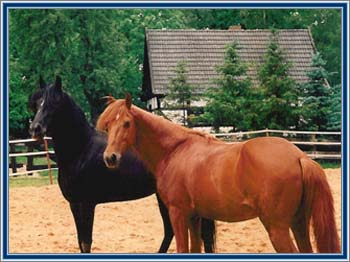
Barb Horses in Germany,
the black stallion
proved to be gaited.
|
|
|
During a visit to a german Company
importing horses from Russia, I rode a Karachaever
stallion (a type of Kabardiner), in gait. Many native
Russian breeds have a tendency to gait. |
|

On my wanderings, I did find some peculiar
saddles. Here my tomcat Bibi is inspecting a
South-American one.
|
In France I also found gaited horses,
imported Peruvian Paso’s. The French bookshops and horse
periodicals informed me about it that in recent
historical times gaited horses could still be found in
Normandy and Brittany. |
|
|
Besides the veterinary study
I found some proper work to do bringing in
dough and enabling me to think about another
horse of my own in earnest. So, you could
find me driving city buses all through
Utrecht! That’s where Tennessee Walkers came
in view. |

As bus-driver in Utrecht,
earning dough
for Buster's keep - what's in a name?
|
|
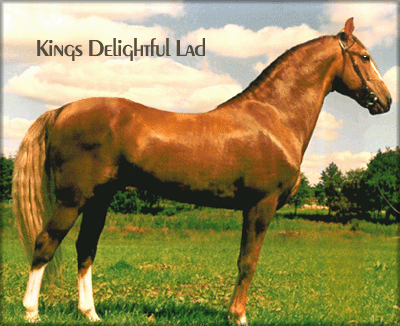 |
We had
heard about a beautiful palomino stud,
Kings Delightful Lad, who had been
showed at the Equitana Fair in Essen, Germany, presented
by a rider of the stables of Ursula Bruns. First, I went
to Holstein with a gaited Dutch Trotter mare
which I leased, to be bred to ”King” as the
stud was called. I bred two fillies this
way, who eventually made their way to other
gaited horse people. |
|
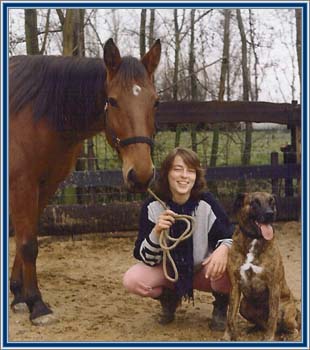
My first gaited horse, Dutch Trotter
"Tennessee Hal",
in foal to Kings Delightful Lad - her sire
was a Standardbred Pacer, son of Tar Heel. |
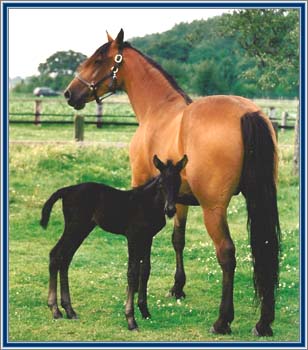
One of the daughters of Tennessee Hal by
Kings Delightful Lad is Delightful Doris,
here with her colt
by a gaited German Trotter. |
|
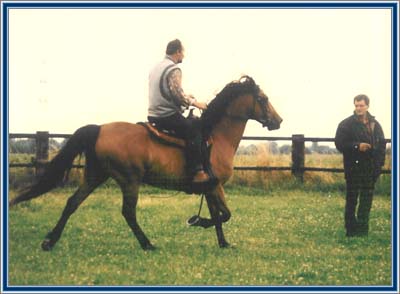
Delightful Doris in gait with owner Horst Manja up,
getting instructions of
Stephan Vierhaus of Gangpferde Vierhaus. They do
important work in promoting gaited horses! |
|
In Holstein I got
acquainted with a whole herd of Tennessee Walkers,
offspring of King and two imported mares. The next major
decision was to buy a young stallion, who got the name
Lad’s Black Buster! |
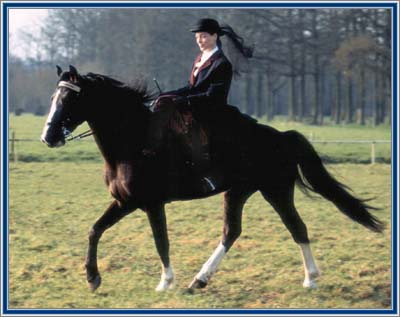
Lad's Black Buster and Maryan,
demonstrating classic sidesaddle equitation....Continued |
 |
|
 |
 |
|